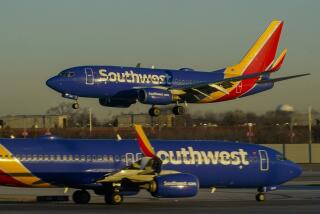Flight Attendants: Still a Struggle for Status, Security : Airlines: Weight, wage and staffing woes are neutralizing the joy of flying for some--a strain that could begin to show in cabin service.
- Share via
It’s been 20 years now since the term “flight attendant” began to replace “stewardess” in airline labor contracts, and 63 years since the first team of eight stewardesses, each one white, under 5-foot-4 and weighing less than 115 pounds, reported for duty on a Boeing Air Transport flight from San Francisco to Chicago.
But that doesn’t mean working conditions for the country’s roughly 100,000 flight attendants have come a long way, baby. In fact, if your cabin crews have seemed more harried and less enthusiastic during this last year or two, there are plenty of possible reasons why:
* Despite legal challenges, most airlines still require attendants to weigh in, and ground them for being overweight.
* Though the job demands odd hours, time away from home and life-or-death responsibilities, attendant salaries begin at about $12,500 a year and average, overall, about $25,000.
* Struggling to cut their losses, airlines are moving to smaller flight crews, which many say has hurt service.
Flight attendants do have good days. Off duty, they can fly nearly free on their own airline, and enjoy vast discounts on others. Under legal pressure in the early 1970s, airlines stopped forcing attendants out of their jobs when they married or reached age 32. The recent ban on smoking aboard domestic flights pleased many who cited health risks. But consider these circumstances:
*
Scales and pounds: With the exception of those at Northwest and Continental airlines, most attendants still weigh in for their bosses. For a 30-year-old, 5-foot-5 female attendant at United Airlines, 135 pounds is the acceptable limit and 148 pounds means grounding. United had suspended its weight penalties in 1991, but reinstituted them April 30, calling them crucial to the “professional image” of its attendants. American Airlines, targeted by a claim to the federal Equal Employment Opportunity Commission, in 1991 agreed with attendants on a revised weigh-in program.
The leading opponent of weight limits is the Assn. of Flight Attendants, which represents attendants from United and 20 other carriers. The group says the limits promote eating disorders and amount to sexism. (About 85% of all flight attendants are women.) In March, the association filed its own EEOC claim, seeking a ban on weight requirements. The EEOC has not taken a position.
Delta suspended its weight standard enforcement in December, 1991, and describes its policy as “under review.” USAir put its weight program into a similar limbo earlier this year.
*
Scales and dollars: With airlines and attendants skirmishing over salaries, passengers can suffer.
After its last contract proposal was rejected, Alaska Airlines imposed new terms on its attendants that included a minimum pay hike of 3% in the first year, but made them foot more of their own medical bills.
The attendants went guerrilla. On Sept. 11, without warning, 17 of them walked off their jobs for about an hour each in Seattle, San Jose, San Francisco and Oakland. One flight was canceled; others were delayed.
At financially troubled USAir, flight attendants in March joined all employees in accepting one-year pay cuts of up to 20%.
At American, where attendants’ base salaries now climb from $14,988 for first-year employees to $38,420 for an international attendant after 14 years, the attendants’ labor contract has been open for amendment since December, 1992, and the two sides can’t even agree on how to describe what’s on the bargaining table.
United, which offers salaries comparable to American’s, signed a contract with its attendants in August, 1991. But early last year the company asked unions for pay cuts and other concessions. Since July, the unions have been in talks with the company, amid word that they may consider cuts in exchange for a majority stake.
*
Staffing and service: After years of exceeding the FAA requirement of one attendant per 50 seats, airlines are cutting back to the minimum on many flights. The carriers pledge this will not affect customers, but many say they’ve already seen longer waits for meals and plate-clearing.
American now provides four attendants on its 727s (150 seats) and MD-80s (142 seats), no matter how many of the seats are empty, and adds a fifth attendant if 110 seats or more are filled. But in American’s current contract talks, the airline is seeking the flexibility to use three attendants when those flights carry fewer than 85 passengers. The airline has already made a similar change on its 757s.
USAir has reduced crews from five to four on many 727s and MD-80s. Similarly, a Delta spokesman says that carrier is “definitely more closely watching staffing levels.”
Amid those and other cost-cutting measures, International Airline Passengers Assn. Washington counsel David Stempler reports that “there has been a feeling from our membership that service has been deteriorating.” Stempler predicts that the industry will evolve into a two-tiered system, with minimal service on shorter flights and full service on longer routes.
*
Reynolds travels anonymously at the newspaper’s expense, accepting no special discounts or subsidized trips. To reach him, write Travel Insider, Los Angeles Times, Times Mirror Square, Los Angeles 90053.
More to Read
Inside the business of entertainment
The Wide Shot brings you news, analysis and insights on everything from streaming wars to production — and what it all means for the future.
You may occasionally receive promotional content from the Los Angeles Times.











